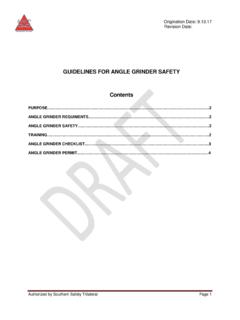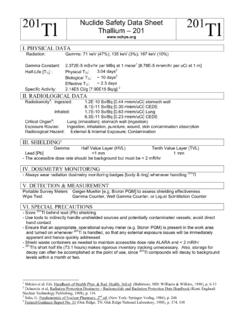Transcription of RESEARCH REPORT 324 - Health and Safety Executive
1 HSEH ealth & SafetyExecutiveWave slap loading on FPSO bowsPrepared by Universities of Glasgow and Strathclydefor the Health and Safety Executive 2005 RESEARCH REPORT 324 HSEH ealth & SafetyExecutiveWave slap loading on FPSO bowsLi Xu and Nigel BarltropDept of Naval Architecture and Marine EngineeringUniversities of Glasgow and Strathclyde100 Montrose StreetGlasgowG4 0 LZSteep wave impact pressures and the structural dynamic response of FPSO (ship-shaped Floating oilProduction Storage and Offloading vessel) bows are studied using 1/80 scale instrumented models andtime domain simulation.
2 The nature of the waves causing large impacts and the impacts themselvesare design rules for curved bows are proposed. The rules account for the effect of the size of theloaded area on the average pressure and the rise and decay times of the average pressure and hencethe dynamic amplification of the REPORT and the work it describes were funded by the Health and Safety Executive (HSE), BP, agrant from EPSRC, associated in-kind industrial contributions, a University/Departmental Scholarshipand an IMarEST Scholarship.
3 Its contents, including any opinions and/or conclusions expressed, arethose of the authors alone and do not necessarily reflect HSE BOOKSii Crown copyright 2005 First published 2005 ISBN 0 7176 2984 8 All rights reserved. No part of this publication may bereproduced, stored in a retrieval system, or transmitted inany form or by any means (electronic, mechanical,photocopying, recording or otherwise) without the priorwritten permission of the copyright for reproduction should be made in writing to: Licensing Division, Her Majesty's Stationery Office, St Clements House, 2-16 Colegate, Norwich NR3 1BQ or by e-mail to This work was performed with funding from HSE and BP, a grant from EPSRC, associated in-kind industrial contributions, a University/Departmental Scholarship and an IMarEST Scholarship.
4 The Authors (Li Xu and Nigel Barltrop) were also taking part in the related SAFE-FLOW EU project (managed by Dr. Bas Buchner of Marin in Holland) and there was a continuous and useful exchange of results and ideas between this project and the partners in the SAFE-FLOW project, particularly Bas Buchner and Arjan Voogt (Marin), Trevor Hodgson (Atkins and now Galbraith Consulting) and Sandy Fyfe (PAFA). A lot was learnt from the regular SUTGEF meetings where wave groups and breaking waves are a frequent subject of discussion especially with Rod Rainey, Chris Swan, Paul Taylor and Peter Tromans.
5 Also Kevin Drake (UCL) who very helpfully provided new-wave analyses at the beginning of the project. The Authors also acknowledge the important technical contributions from: Barbaros Okan ( RESEARCH assistant for the Schiehallion experiments) Bill Wright Bernard Reilley Jack Sharky Donald Nicholson (Model making) Grant Dunning David Sinclair Donald Nicholson (Testing) Frank Sweeney David Percival (Electronics and Data Acquisition) iii iv CONTENTS Executive Summary 1 Introduction 1 2 Waves 3 Introduction 3 Highest new-waves 5 Steep fronted new-waves 10 Constrained random waves 13 Spread seas 19 Other types of extreme wave groups 22 Concluding remarks 23 3 Model & testing method 25 Model design 25 The models 31 Additional measurements
6 45 Data acquisition 47 Calibration and assessment of calibration errors 50 Experimental procedure 53 4 Experimental Results 59 Wave groups 59 Constrained random waves 61 Applicability of wave group and random wave tests 62 Frequency cut-off study 63 Target position study 64 Steepness balance study 65 Wave shape study 69 Slapping wave probabilities 71 Wave front steepness enhancement 71 Celerity of critical waves 72 Velocity balance study 73 Sea state study 73 Jonswap peak enhancement study 76 Draft study 76 Yaw angle study 76 Pressure-area relationships 77 Pressure rise and half decay times 78 Bottom slamming forces 79 Hull girder bending moments 80 5 Approximate calculations 83 Approximate kinematics in the experimental breaking waves 83 Including some non-linear behaviour in wave group models 85 Cylinder pressure area
7 Relationships 89 Slamming simulation 94 6 Derivation of design guidance 103 Breaking wave type related to sea-state steepness 103 v Velocities in the crest of the slapping wave 105 Shape of the crest of the slapping wave 106 Relative pressure loads from different steepness sea-states 106 Effect of spectral shape 108 Effect of directional spreading 108 Average loading on different areas of the bow 110 Limiting pressures on very small areas 111 Dynamic amplification factors 112 Final form of the design equations 114 7 Summary & Conclusions 117 Summary 117 Waves 117 Ship models 123 Test results 124 Mathematical models 125 Design guidance 127 Future work 128 Appendix A Tables of data 129 References 146 vi Executive SUMMARY In 1989 the Schiehallion FPSO suffered bow damage from the large approximately horizontal forces when a steep fronted wave impacted the bow.
8 The uncertainty in how to design for this type of slap loading became a concern to the oil industry and the regulators. The Naval Architecture Department at Glasgow University (Now Naval Architecture & Marine Engineering (NAME) of Glasgow & Strathclyde Universities) had just been awarded an EPSRC-Link grant to RESEARCH the wave frequency and impulsive loading on FPSOs in extreme seas. Additional funds were provided by BP, HSE and, later, University and IMarEST Scholarships. This enabled the Schiehallion FPSO, which had a blunt elliptical bow and a tanker (Loch Rannoch) with a more conventional bow shape to be model tested in the department s Acre Road tank (76m long, wide, overall depth) and for a considerable amount of desk based investigation.
9 The RESEARCH workers on this project were also subcontractors for structural work in the related SAFE-FLOW JIP/EU project which considers bow and green water impacts on FPSOs and which completed early in 2004. There was a considerable interchange of information between this project and the SAFE-FLOW project and this project was reported at the regular SAFE-FLOW meetings. The two projects were complementary: This project tested complex models of curved bows whereas SAFE-FLOW concentrated on flat plate bows.
10 This project concentrated on representing random seas by special extreme wave groups (related to New-wave theory) whereas SAFE-FLOW concentrated on running irregular waves. This work has increased the understanding of the nature of the breaking waves that can cause large slap forces that are important for the design of offshore floating structures (and should also be relevant to ship design). Methods of generating model scale wave groups that should produce approximately the 1 in 3 hour maximum loads, when large waves break in unidirectional sea states prescribed by Hs and Tz, have been developed.














